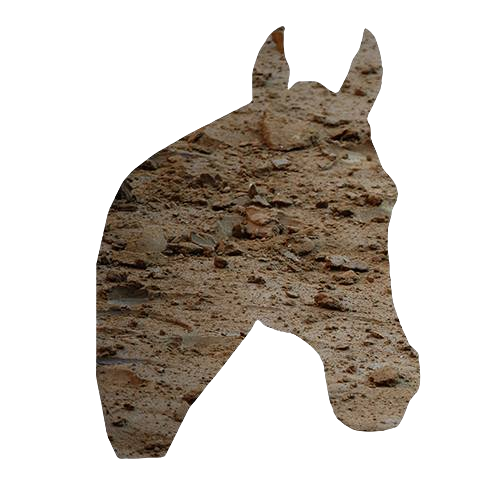www.thepalio.eu - dal Belgio con amore
Siena : tourist guide
This is a list of the main attractions of Siena with, so to speak, opening hours, which are sometimes adjusted.
The most important advice for every visitor, however, is to walk, walk and wander again and get lost is also allowed. This is the only way to discover nooks and crannies, be surprised by astonishing vistas through alleys, discover in Salicotto a rare mini-park created in the 1930s during the redevelopment of the neighborhood or what remains of the ghetto and, if you’re lucky that the gate is open, the seemingly endless tunnel under higher level houses in which the Torraioli store their tables and chairs for their feasts.
See how steep it is for Lupaioli and Brucaioli to leave their neighborhood, and discover the formidable stables of especially Civetta, Selva, Aquila, Giraffa and Chiocciola, and the covered medieval fountains of Oca in Fontebranda and of Lupa in Ovile.
And nothing more romantic than an evening stroll on the Via del Costone on the edge of the old town from Selva over Fontebranda in Oca to the San Domenico church in Drago.
An attentive visitor will quickly notice that Siena is very different from other Tuscan cities such as Florence, Pisa, Lucca, Pistoia, Prato and Arezzo. Less natural stone, which you will mainly find in the remains of medieval family towers and early Renaissance palaces, less plastered facades (dating from after the conquest by Florence in 1555), but a dominant red-brown brick in palaces and some pavements, such as on the Campo.
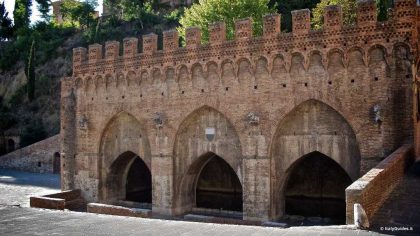
Neighborhoods – Contrade
A map of the city is necessary, preferably with the borders of the contrade. In Siena, neighborhoods have double names: the original place name and that of the contrada.
| Aquila | Casato | Nicchio | Pispini |
| Bruco | Via del Comune | Oca | Fontebranda |
| Chiocciola | San Marco | Onda | Malborghetto |
| Civetta | Castellare | Pantera | Stalloreggi |
| Drago | Camporegio | Selva | Vallepiatta |
| Giraffa | Provenzano | Tartuca | Castelvecchio |
| Istrice | Camollia | Torre | Salicotto |
| Leocorno | Pantaneto | Valdimontone | Via dei Servi |
| Lupa | Vallerozzi |
Use the checkmarks to turn certain things on and off to make it clearer.
You can also tap on a neighborhood to zoom in.
Open in a new window via siena.palio.be
PIAZZA DEL CAMPO and Surroundings
Any visit to Siena begins or ends in Piazza del Campo. The square is largely a creation of the early 14th century when Siena was ruled by I Nove or The Nine Lords. Shortly before 1300, they bought land and a few houses on a meadow intended to become the new city centre.
Palazzo Pubblico or Comunale
Between 1297 and 1310, the Palazzo Pubblico or Comunale or City Hall was built. An interior visit is highly recommended. One enters through the cortile or large courtyard where the Palio is presented and where during the Palio days the horses are tied to one of the 10 pillars in anticipation of the race. The most beautiful things are of course the frescoes from the early 14th century. Two rooms are a must : the Sala del Mappamondo or Room of the World Map. Ambrogio Lorenzetti had a round panel mounted in the wall with a world map. The map has disappeared, the outline of the circle is still visible. On one side you see the Maestà or Enthroned Madonna with Saints by Simone Martini (1315) and on the other side above the outline of the map Martini’s Guidoriccio da Fogliano (1328), a condottiere or captain of a mercenary army in the service of the republic.
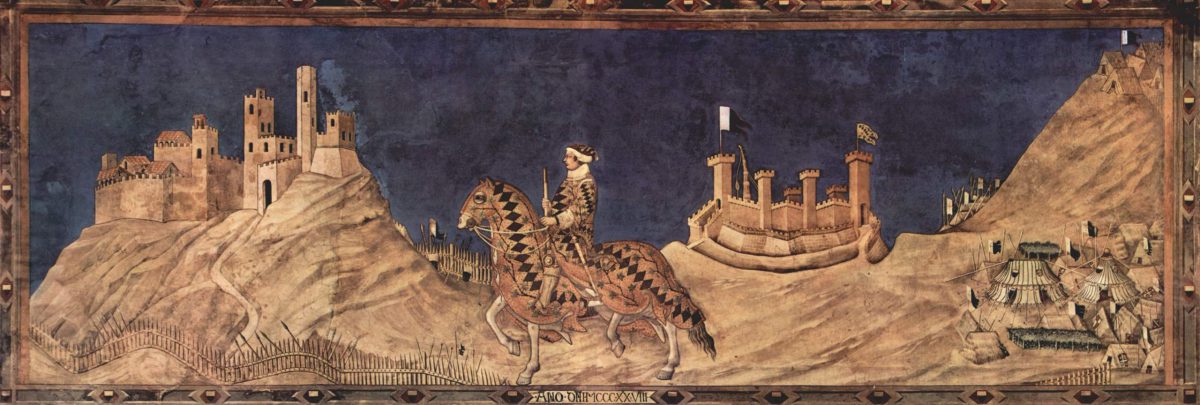
In the Sala dei Nove o della Pace (Hall of the Nine or of Peace) you can admire the Allegories of Good and Evil Reign (1338-1339) by Ambrogio Lorenzetti, already discussed in the History of Siena.
In the Sala dei Priori or della Balia you can see frescoes by Spinello Aretino and his son Parri Spinelli illustrating the life of the first Sienese pope Alexander III.
There are other halls and chapels with interesting frescoes, mostly from the 14th century, and on the top floor the loggia where the Nine could get some fresh air in the evening.
Open : daily from 10am to 7pm (from 16/3 to 31/10, otherwise until 6pm)
Tickets: 10 euros.
Two combined tickets :
- 14 euros for town hall and Santa Maria della Scala
- 20 euros for town hall and Santa Maria della Scala and Torre del Mangia
Torre del Mangia
Between 1325-1348, the Torre del Mangia was built, the 104 meters high, slender and feminine tower, compared to that of the Palazzo Vecchio in Florence, which is more robust and masculine. At the top hangs the Sunto or alarm clock which is rung at the start of the corteo storico for each Palio and which stops exactly 2 hours and 10 minutes later when the horses leave the cortile of the town hall. You can climb the tower via a narrow and steep corridor and at the top you will be rewarded with a phenomenal view of the Piazza, the city and the countryside.
Open : 10 am to 7 pm ( from 1/3 to 15/10)
Tickets: 10 euros. See above for combined ticket
Piazza del Campo
In 1333-1334 the beautiful fan-shaped pavement of the Piazza was built, resembling the protective cloak of the Madonna, patroness of Siena, according to some, but actually divided in nine after the Nine Lords who ruled the city. Over the town hall is a copy of the original Fonte Gaia by Jacopo della Quercia. The heavily weathered original is now in the Santa Maria della Scala museum complex.

Next to Piazza del Campo
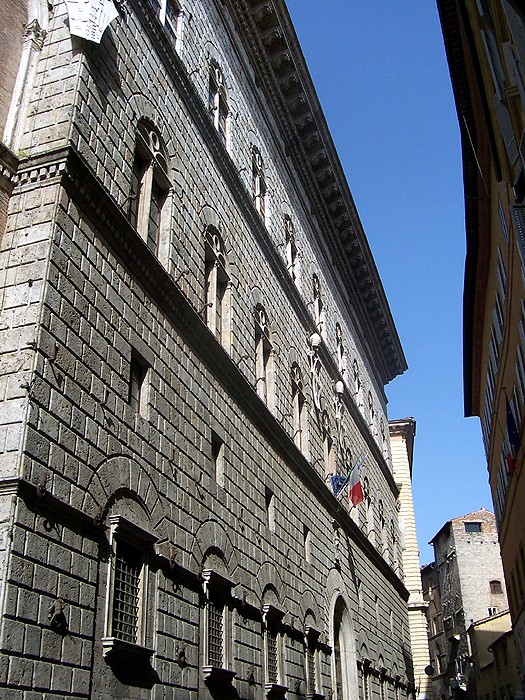
Leave the square to the left via Via Rinaldini, called Chiasso Largo in Siena, and you will immediately see the impressive Palazzo Piccolomini, a rather rare Renaissance construction in Siena, built for the family of Pope Pius II. A little further and separate from the palace is the Loggia del Papa, a loggia built by the pope with which he offered his fellow citizens free protection and coolness against the scorching summer sun.
The palazzo Piccolomini houses the Archivio di Stato or State Archives, usually a dull affair but not here. From the 12th to the 16th century it was the custom in Siena to assemble documents of one working year, drawn up by the Biccherna or the Ministry of Finance of the Republic, and to put a painted leather cover on the front. Often painted by prominent masters, these Biccherne illustrate historical facts and the daily life of the town. Recommended for gourmets because unique and refined, and … hardly visited .
Open: Monday to Saturday, entry at 9.30am and 10.30am and 11.30am each time for 1 hour. Maximum 25 people per entrance. Free.
Closed from 1 to 16 August.
Accessible through the courtyard of the Palazzo.
DUOMO and Surroundings
The second highlight is the Duomo. One buys a ticket that gives access to the six parts of the complex: Duomo, Libreria Piccolomini, Museo dell’Opera del Duomo, Panoramic View of the Facciatone, Battistero and Crypt.
Duomo
The Duomo itself, whose interior is sometimes irreverently referred to as the interior of a zebra, was built in several stages between 1220 and 1370.
The most beautiful is probably the pulpit from 1266-1268 by Nicola Pisano, a highlight of Gothic sculpture on an octagonal base with 7 reliefs and resting on 8 columns, four of which are on the backs of lions. If you look closely, you will see that Pisano was often inspired by ancient sarcophagi. The Madonna resembles a Roman matron.
Furthermore, a beautiful bronze John the Baptist (1455) by Donatello, and on a rather surprisingly small size the 4 saints, San Pietro and San Pio on the left and San Paolo and San Gregorio Magno on the right (1501-1504) by Michelangelo. He had a contract to make 12 statues for Francesco Piccolomini Todeschini, the later Pius III who was pope for only 27 days. He delivered only four and, decades later, had to repay part of his fee to the Piccolomini. Nor are they his best works. He must have had his head on grander assignments like the David of Florence.
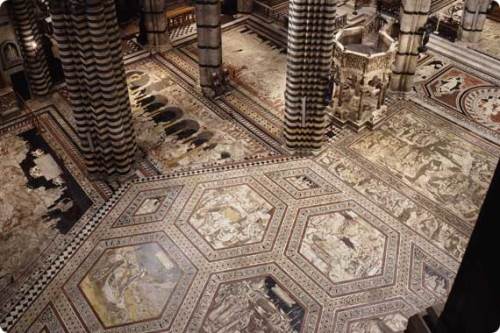
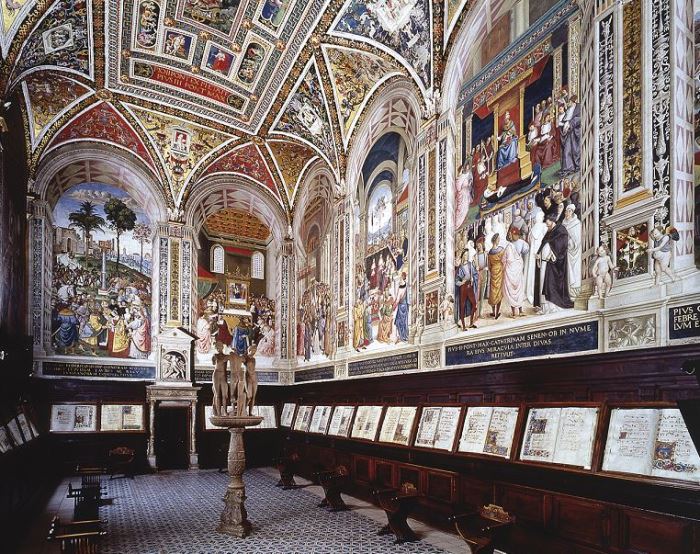
The Duomo is especially famous for its marble floor with no fewer than 56 large and small representations of fifteenth and early sixteenth century marquetry, which are not always visible, however.
Libreria Piccolomini
From the interior of the cathedral itself, one can enter the Libreria Piccolomini on the left, a room with frescoes by Pinturicchio illustrating the life of Pope Pius II Piccolomini: charming, very decorative but slightly too stiff frescoes (1502-1507). Totally unexpected, because in a church room, there is a Roman statue group of the Three Graces in the room.
The skeleton of the unfinished church and the Facciatone
To the right of the church is the impressive skeleton of the new main nave never completed due to the Black Death of 1348, with the Facciatone or grand façade at the back, which should have been the entrance to the enlarged church.
Museo dell’ Opera del Duomo
In the construction you will find the entrance to the so-called Museo dell’ Opera del Duomo, in which are collected art treasures from the Duomo that are perfectly displayed, especially painting and sculpture but also the original Chancel window (1287-1288), designed by Duccio di Buoninsegna , and replaced in the church with a copy. In the same room hangs a magnificent marble Madonna relief by Donatello.
The highlight is the Maestà or enthroned Madonna with Saints and Angels by the same Duccio. On display separately are the dozen or so small panels from the back of the Maestà depicting the Life of Christ, of exceptional quality and refinement, and among the best that can be seen from the Middle Ages. Among them are some other excellent works by Duccio and Pietro Lorenzetti.
From the Museo dell’Opera itself, a staircase leads to the panoramic open-air balustrade on the Facciatone for another impressive view of Siena and its surroundings.
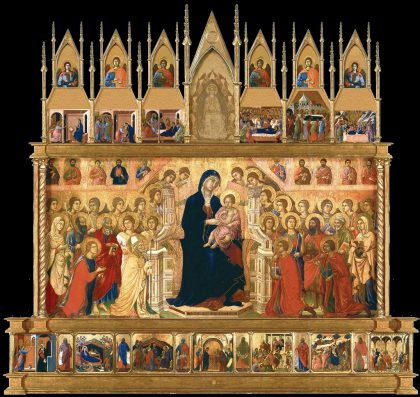
Battistero
Via the beautiful stairs one goes to the Battistero or baptistery behind and under the choir of the church. The chapel is decorated with frescoes by Il Vecchietta, but its great pride is the baptismal font with 6 panels illustrating the life of John the Baptist. Three reliefs stand out: Donatello’s Banquet of Herod with the Dance of Salome, and Ghiberti’s Capture of the Baptist and The Baptism of Christ by John, absolute highlights of goldsmithing.
Crypt
Close by you will find the entrance to the crypt of the church. In 1999, during renovation works at the Dom, an underground space of 180 m² was accidentally discovered. This was part of the original cathedral that was covered with the new cathedral after 1220. The crypt was filled with rubbish in the 14th century when static problems were identified in the new church. The space gives a good idea of the old church and especially the frescoes by anonymous masters and among the oldest in Tuscany are surprisingly well preserved.
I recommend a low-cost OPASIPASS that gives access to the Duomo, the Libreria Piccolomini, the Museo dell’Opera del Duomo and the Facciatone, the Battistero and the cripta.
open : 10.30 to 19.00 (1/3 to 2/11, otherwise until 17.30)
Please note: the Duomo closes at 6 pm and does not open until 1.30 pm on Sundays.
price :
- 01/01 – 26/06; 01/08 – 17/08; 19/10 – 31/12: € 13.00.
- 27/06 – 31/07; 18/08 – 18/10: € 15.00. (if the floor is visible)
Opposite the entrance to the Duomo is the medieval Ospedale Santa Maria della Scala. It was built from 1090, considerably enlarged between 1320 and 1330 to its current size and appearance. It was the largest hospital of the Middle Ages.
It is worth a visit and you will have access to several rooms such as Il Pellegrinaio, a formidable room with frescoes from the 15th century by Domenico di Bartolo, Priamo della Quercia and Il Vecchietta. They represent works of mercy as exercised by the Ospedale towards the sick, the dying, the poor, orphans and pilgrims. The frescoes are somewhat rough, but give a strong image. You can also visit the Museo Archeologico, and the original Fonte Gaia by Jacopo della Quercia. You can see a copy on the Campo.
Open : daily from 10.30 am to 6.30 pm
Tickets: 9 euros. See above the cumulative tickets under the Palazzo Pubblico.
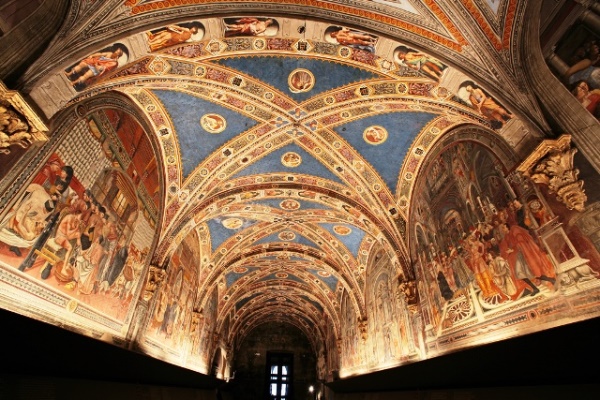
Evening walk on the Costone
From Piazza San Giovanni, the small square in front of the Battistero behind and below the Duomo, turn into Via Franciosa, after 80 meters turn right into small Via Pozzo and immediately left into Via Vallepiatta, the heart of Selva. After about 70 meters the Via del Costone begins on the right along the old city walls to the valley of Fontebranda in Oca and back up to San Domenico in Drago. Especially in the evening it has something fairytale like, and especially during the Palio days.
From the PORTA CAMOLLIA to the PORTA SAN MARCO
There is a long street from the north, the Porta Camollia, to the south, the Porta di San Marco. The street changes its name several times and along the way you pass several highlights of the city. From the long Via Camollia, heart of Istrice, and Via Montanini one enters the elegant main shopping street, Via Banchi di Sopra, which just past the rear of Campo becomes Via di Città, and after the exit to Duomo Via Stalloreggi becomes, the heart of Pantera. Through a smaller medieval inner gate you enter the elongated Pian dei Mantellini and on the left you walk along Via San Marco, heart of Chiocciola, out of the old town.
At the beginning of via Banchi di Sopra there is a small square with 3 palaces, on the left 16th century High Renaissance, central Sienese Gothic, and on the right 15th century Early Renaissance. This is the headquarters of the Banca Monte dei Paschi di Siena, the oldest active bank in the world, founded in 1472 as a Monte di Pietà and later developed into a bank.
The bank is open to visitors on the morning of the Palio of July 2 and on the morning of August 15, the day before the Palio of August 16. In addition to the impressive medieval halls and an ultra-modern central staircase, you can also see the large art collection and some beautiful historic Palio paintings. Recommended.
A hundred meters further in the Banchi di Sopa you come to the Piazza Tolomei with the eponymous Gothic Palazzo Tolomei on the right. It is the oldest surviving bank building in the world and still a bank today. Originally built in 1205, but after destruction by the Ghibelline faction in 1266, it was completely rebuilt in its present form in 1267.
Another 100 meters further on the left you will see the Loggia della Mercanzia or the meeting complex of the merchant guild, built between 1417 and 1444 in a style that wavers between late Gothic and early Renaissance. From here you can access the Piazza del Campo through arcades under the houses.
The Via Banchi dei Sopra changes here into the Via di Città. In the middle of this street you will find the beautiful Gothic Palazzo Chigi Saracini, built at the end of the 12th century by the Marescotti and later rebuilt by the Piccolomini and finally acquired by the Saracini.
It is the seat of the Academia Musicale Chigiana founded in 1932 by Count Guido Chigi Saracini (1880-1965). Masterclasses are given here annually by leading classical conductors and musicians to the world’s most promising talents. In the summer, concerts are given by the teachers and students there and in the city and the province. Be sure to enter to the inner courtyard. Count Chigi Saracini was also Captain of Istrice and Rector of the Magistracy of the Contrade. Read also: Una giornata particolare, about the contrade and Hitler’s visit to Florence.
Another 100 meters further you will find the intersection of the Quattro Cantoni. Go left in Via San Pietro to the Pinacoteca.
Pinacoteca Nazionale
The museum contains a fine collection of mainly Sienese artists such as Duccio di Buoninsegna, Simone Martini, Ambrogio and Pietro Lorenzetti and other minor but interesting artists. As mentioned in the History and Culture of Siena on this site, the Sienese were the world’s top between 1280 and 1345, well until 1400, but they did not fit in with the Florentine innovations afterwards.
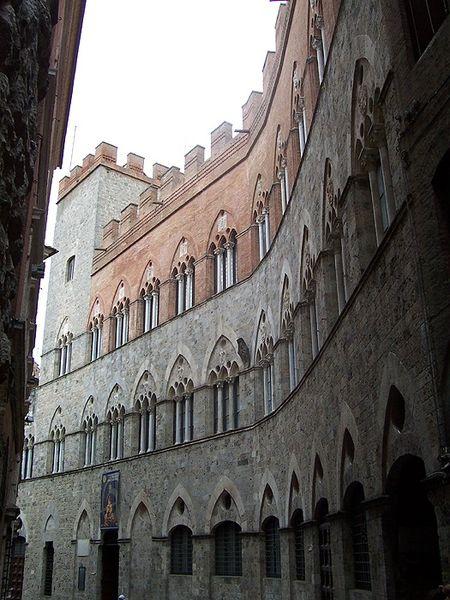
Via San Pietro 29
open : Tuesday to Friday – 8.15 to 19.15 || Sunday and Monday – 9-13
ticket: 8 euros
On the right you go through Via del Capitano to the Duomo and Santa Maria della Scala. On the left of the street is the Palazzo del Magnifico from 1508, ie by Pandolfo Petrucci, the only dictator of Siena. Read The History of Siena. Straight ahead you will enter Via di Stalloregi, the heart of Pantera and Siena becomes a quieter town.
Other walks :
From the main seat of the Montepaschi you descend into via della Sapienza and after approx. 100 you can descend even steeper on the left into Via Costa di Sant’Antonio to the Santuario di Santa Caterina, the birthplace of the saint, thoroughly renovated in 1464 after her canonization in 1461. Sienese are very proud of this patroness of Europe. Oca uses the shrine courtyard to walk and wash their horse after each prova.
In Via Banchi di Sopra you can go to Bruco and Giraffa next to libreria Feltrinelli under an arcade. The street also leads to the Gothic San Francesco, a very spacious church built in 1228-1255. The church contains interesting frescoes by Ambrogio Lorenzetti and panels by his brother Pietro and Sassetta.
But Siena has much more to offer : the quiet areas of Pantera, Selva, Onda, Aquila, Tartuca and Civetta (around the early medieval centers of Castelvecchio and Castellare respectively) and Oca are also attractive. Torre, on the other hand, is a rehabilitated neighborhood from the 1930s where an attempt has been made to integrate the style into the old architecture of Siena.
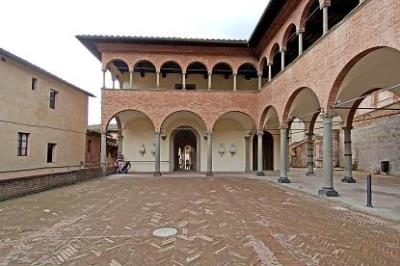
LITERATURE
Damien Wigny : Sienne et le Sud de la Toscane, new edition 1998
Damien Wigny, ex-director of KB-Lux, living in Gaiole in Chianti, crushes every other guide to Siena and province with this exceptionally voluminous guide.
Useful is the Capitol Guide to Florence and Tuscany.
